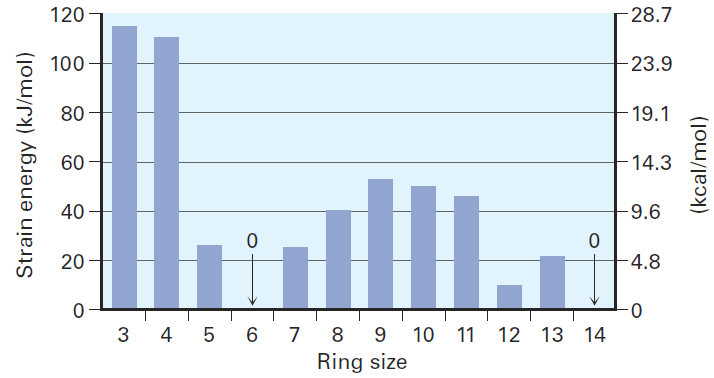
Stability of Cycloalkanes: Ring Strain
 المؤلف:
John McMurry
المؤلف:
John McMurry
 المصدر:
Organic Chemistry
المصدر:
Organic Chemistry
 الجزء والصفحة:
9th - p95
الجزء والصفحة:
9th - p95
 12-5-2016
12-5-2016
 4691
4691
Stability of Cycloalkanes: Ring Strain
Chemists in the late 1800s knew that cyclic molecules existed, but the limitations on ring size were unclear. Although numerous compounds containing five-membered and six-membered rings were known, smaller and larger ring sizes had not been prepared, despite many efforts.
A theoretical interpretation of this observation was proposed in 1885 by Adolf von Baeyer, who suggested that small and large rings might be unstable due to angle strain—the strain induced in a molecule when bond angles are forced to deviate from the ideal 109° tetrahedral value. Baeyer based his suggestion on the simple geometric notion that a three-membered ring (cyclopropane) should be an equilateral triangle with bond angles of 60° rather than 109°, a four-membered ring (cyclobutane) should be a square with bond angles of 90°, a five membered ring should be a regular pentagon with bond angles of 108°, and so on. Continuing this argument, large rings should be strained by having bond angles that are much greater than 109°.

What are the facts? To measure the amount of strain in a compound, we have to measure the total energy of the compound and then subtract the energy of a strain-free reference compound. The difference between the two values should represent the amount of extra energy in the molecule due to strain. The simplest experimental way to do this for a cycloalkane is to measure its heat of combustion, the amount of heat released when the compound burns completely with oxygen. The more energy (strain) the compound contains, the more energy (heat) is released by combustion.

Because the heat of combustion of a cycloalkane depends on size, we need to look at heats of combustion per CH2 unit. Subtracting a reference value derived from a strain-free acyclic alkane and then multiplying by the number of CH2 units in the ring gives the overall strain energy. Figure 1-1 shows the results.

Figure 1-1 Cycloalkane strain energies, calculated by taking the difference between cycloalkane heat of combustion per CH2 and acyclic alkane heat of combustion per CH2, and multiplying by the number of CH2 units in a ring. Small and medium rings are strained, but cyclohexane rings and very large rings are strain-free.
The data in Figure 1-1 show that Baeyer’s theory is only partially correct. Cyclopropane and cyclobutane are indeed strained, just as predicted, but cyclopentane is more strained than predicted, and cyclohexane is strain-free. Cycloalkanes of intermediate size have only modest strain, and rings of 14 carbons or more are strain-free. Why is Baeyer’s theory wrong? Baeyer’s theory is wrong for the simple reason that he assumed all cycloalkanes to be flat. In fact, as we’ll see in the next section, most cycloalkanes are not flat; they adopt puckered three-dimensional conformations that allow bond angles to be nearly tetrahedral. As a result, angle strain occurs only in three- and four-membered rings, which have little flexibility. For most ring sizes, particularly the medium-ring (C7–C11) cycloalkanes, torsional strain caused by H←→H eclipsing interactions at adjacent carbons and steric strain caused by the repulsion between nonbonded atoms that approach too closely) are the most important factors. Thus, three kinds of strain contribute to the overall energy of a cycloalkane.
• Angle strain—the strain due to expansion or compression of bond angles
• Torsional strain—the strain due to eclipsing of bonds between neighboring atoms
• Steric strain—the strain due to repulsive interactions when atoms approach each other too closely
 الاكثر قراءة في الهايدروكاربونات
الاكثر قراءة في الهايدروكاربونات
 اخر الاخبار
اخر الاخبار
اخبار العتبة العباسية المقدسة


